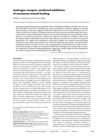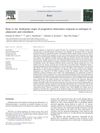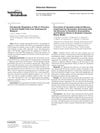Skeletal Site-Dependent Expression of the Androgen Receptor in Human Osteoblastic Cell Populations
December 1997
in “
Calcified Tissue International
”
TLDR Higher androgen levels and site-specific AR expression cause sex-related skeletal differences, and certain steroids can boost AR expression and androgen effects in bone cells.
The study investigated the expression of androgen receptors (AR) in human osteoblastic cells (HOCs) from different skeletal sites in males and females aged 2-69 years. It found that both sexes had similar AR mRNA levels and androgen binding sites, but mandibular and cortical HOCs exhibited higher AR expression and greater mitogenic responses to dihydrotestosterone (DHT) compared to iliac crest-derived and trabecular HOCs. AR mRNA levels and androgen binding sites were higher in early adulthood. Additionally, glucocorticoids, 17β-estradiol (E2), and 1,25-dihydroxyvitamin D3 (D3) increased AR expression and enhanced the mitogenic response to DHT. The study concluded that higher androgen levels in males and site-specific AR expression contribute to sex-related skeletal differences, and that certain steroids can regulate AR gene expression and enhance androgenic effects in HOCs.



